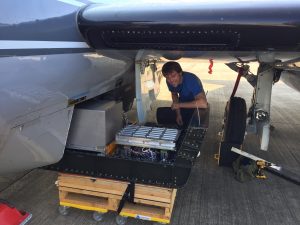3 May 2017
High-altitude aircraft data may help improve climate models
Posted by Nanci Bompey
By Karin Vergoth
Sulfur dioxide released from volcanoes or power plants causes acid rain and leads to particles that play a role in breaking down the protective ozone layer high in the atmosphere. But those particles also reflect sunlight away from Earth, leading some to propose that people could inject sulfur dioxide (SO2) high in the atmosphere to mitigate global warming. New research in Geophysical Research Letters provides the first actual measurements of the chemical, SO2, in the tropical upper troposphere/lower stratosphere—and there’s a whole lot less than some scientists estimated.
“These new data will be important for improving climate models, evaluating satellite data, and understanding the potential of climate intervention scenarios,” said lead author Andrew Rollins, a scientist with the Cooperative Institute for Research in Environmental Sciences (CIRES) at the University of Colorado Boulder who works in the NOAA Earth System Research Laboratory (ESRL).

The NASA WB-57 high-altitude research aircraft in flight. A new study used the high-altitude NASA aircraft to collect SO2 and other data from near the surface to nearly 12 miles high in the atmosphere.
Credit: NASA
Scientists often use field missions to independently confirm or validate accuracy of satellite-based data. The NOAA-funded VIRGAS mission (Volcano-plume Investigation Readiness and Gas-phase and Aerosol Sulfur), was important in that it determined that satellite-based estimates of the chemical and its impact on stratospheric aerosol were far too high, according to Rollins and his colleagues.
The team used a high-altitude NASA aircraft, a WB-57F, to collect SO2 and other data from near the surface to nearly 12 miles high in the atmosphere. Sulfur dioxide was a focus because the chemical plays a principal role in connecting natural and human emissions of sulfur to major environmental issues such stratospheric aerosol formation and climate change.
Scientists have been especially eager to understand the role of tropospheric or low-level SO2, emitted from the Earth’s surface, in maintaining background amounts of higher-level or stratospheric aerosols. There, particles serve to cool the planet by reflecting away sunlight, but they can also play a role in the destruction of ozone. Stratospheric ozone absorbs some of the ultraviolet radiation from the Sun, protecting Earth’s surface from harmful amounts that cause skin cancer and damage crops.
During VIRGAS, Rollins and his colleagues installed their instruments on the NASA aircraft to make the first in-situ measurements of sulfur dioxide in the tropical upper tropopause and lower stratosphere. Then, the team used those measurements to evaluate climate models and satellite data. They also used data collected during the mission to understand how much stratospheric aerosol could actually be formed by SO2 transported from the troposphere.

Andrew Rollins installs the CSD SO2 instrument on the NASA WB-57 high-altitude research aircraft, preparing for the start of the October 2015 VIRGAS field experiment based in Houston.
Photo: Ru-Shan Gao, NOAA
Together, these analyses show that background levels of SO2 are about five times smaller than suggested by satellite observations—including satellite data that have been used to calculate the role of tropospheric SO2 in stratospheric aerosol formation. This shifts the view of sulfur dioxide as a dominant source of stratospheric aerosols to a near-negligible one, said Rollins’s co-author, NOAA scientist Karen Rosenlof, and it reveals a significant gap in scientists’ understanding of the stratospheric aerosols budget.
“Knowing which models correctly simulate observed SO2 in the lower stratosphere gives us a greater ability to both project the future of the stratospheric aerosol layer and estimate the impact of proposed climate change mitigation strategies,” Rosenlof said.
Some proposals suggest direct injection of SO2 into the lower stratosphere could be used to mitigate global warming. The new measurements provide a benchmark that can build confidence in scientists’ understanding of sulfur chemistry in the upper troposphere and lower stratosphere, the new paper concludes. Now, the new information can be used to test models and satellite data that may be used in the future, to evaluate climate intervention scenarios.
— Karin Vergoth is a science writer at CIRES-NOAA. This post originally appeared as a press release on the CIRES website.










 GeoSpace is a blog on Earth and space science, managed by AGU’s Public Information staff. The blog features posts by AGU writers and guest contributors on all sorts of relevant science topics, but with a focus on new research and geo and space sciences-related stories that are currently in the news.
GeoSpace is a blog on Earth and space science, managed by AGU’s Public Information staff. The blog features posts by AGU writers and guest contributors on all sorts of relevant science topics, but with a focus on new research and geo and space sciences-related stories that are currently in the news.